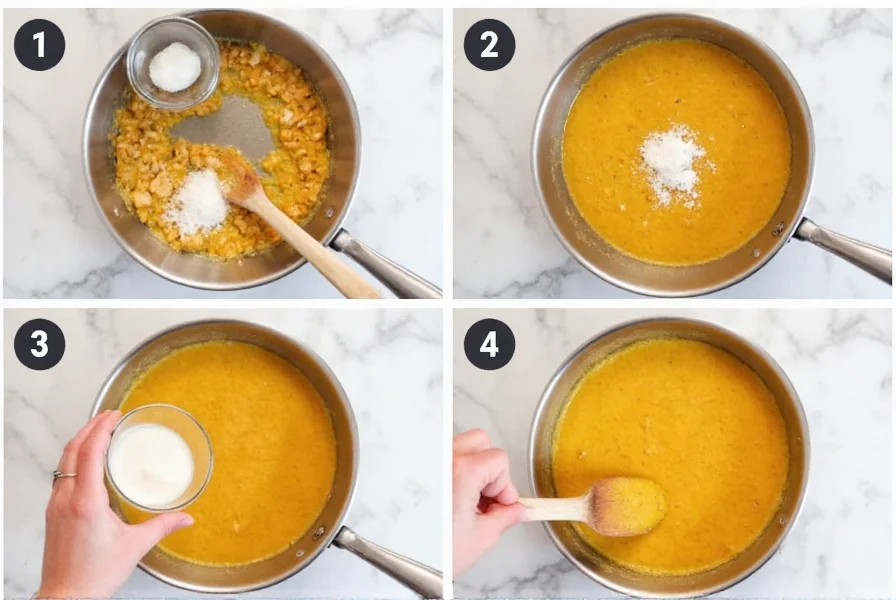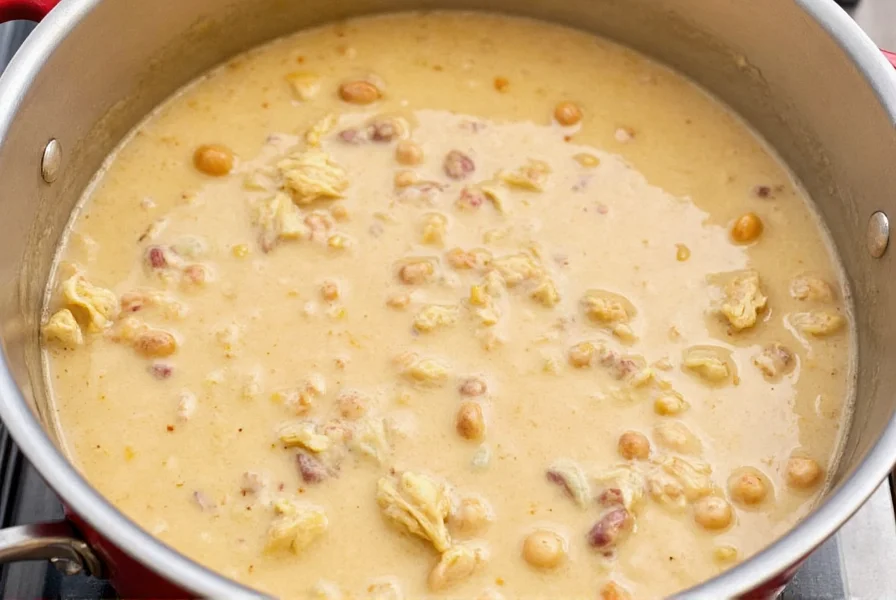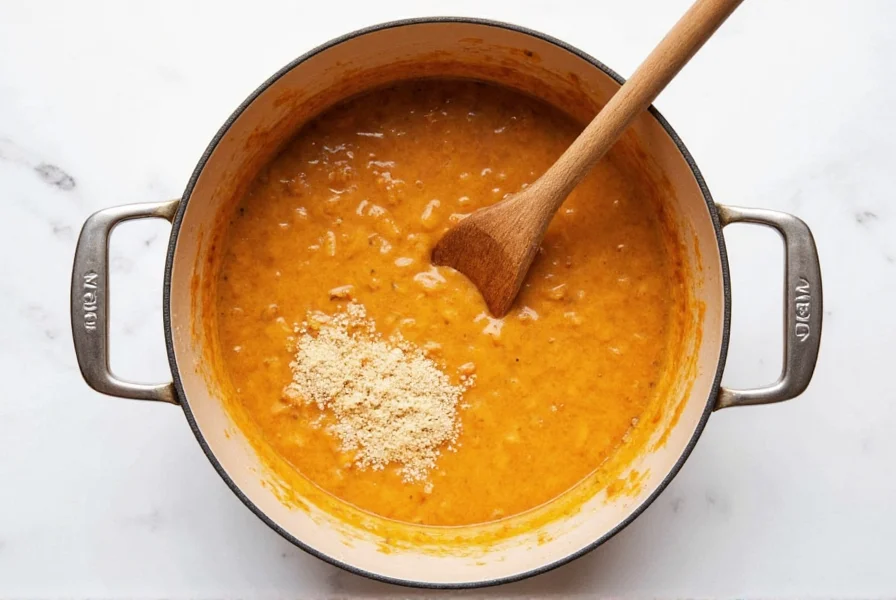The quickest and most effective way to thicken white chicken chili is by using a cornstarch slurry (1 tablespoon cornstarch mixed with 1 tablespoon cold water per cup of chili), adding it gradually while simmering. Alternative methods include simmering uncovered to reduce liquid, adding pureed white beans, incorporating a white roux, or stirring in a small amount of heavy cream or sour cream near the end of cooking.
White chicken chili's delicate flavor profile requires careful thickening techniques that won't compromise its signature creamy, tangy taste. Unlike traditional red chili, white chicken chili features ingredients like white beans, chicken, green chilies, and often a dairy component, making certain thickening methods more suitable than others. Getting the consistency right transforms your chili from soup-like to the perfect hearty, spoon-coating texture that carries all the flavors together.
Why Your White Chicken Chili Might Be Too Thin
Several factors can leave your white chicken chili thinner than desired. Overestimating liquid measurements, using canned ingredients with excess liquid, or not allowing sufficient simmering time all contribute to a runny consistency. The natural starches in white beans and corn need proper time to release their thickening properties. Understanding these causes helps you select the most appropriate correction method without compromising your dish's integrity.
Method 1: The Cornstarch Slurry Technique
Cornstarch provides a neutral-flavored thickening solution ideal for white chicken chili. Unlike flour, it won't create a 'raw' taste and maintains the pale color that defines white chili.
Step-by-step process:
- Mix 1 tablespoon cornstarch with 1 tablespoon cold water per cup of chili you need to thicken
- Whisk thoroughly until completely smooth with no lumps
- Reduce chili heat to medium-low (prevents clumping)
- Slowly drizzle in the slurry while stirring constantly
- Bring to a gentle simmer for 2-3 minutes until thickened
- Repeat with additional slurry if needed, but wait 5 minutes between additions
This method works exceptionally well for white chicken chili because cornstarch activates at lower temperatures than flour, preserving the delicate dairy elements often found in white chili recipes. Avoid adding dry cornstarch directly to hot liquid as it will clump immediately.

Method 2: Simmering and Reducing
Sometimes the simplest solution works best. Allowing your white chicken chili to simmer uncovered gives liquid time to evaporate naturally, concentrating flavors while thickening the broth.
Optimal simmering technique:
- Maintain a gentle simmer (not a rolling boil)
- Cover partially with lid, leaving a small gap
- Stir occasionally to prevent sticking
- Reduce by 15-20% for ideal white chili consistency
- Check every 5-7 minutes after first 15 minutes
This method enhances flavor complexity as the chili reduces, but requires patience—typically 20-30 minutes depending on initial liquid content. It's particularly effective when your chili contains ingredients like tomatillos or green chilies that release additional liquid during cooking.
Method 3: Adding Pureed Beans
White chicken chili typically contains cannellini or great northern beans, making this method both practical and flavor-compatible. Pureeing some of the beans integrates seamlessly while adding body.
| Bean Type | Amount for 6 Servings | Texture Result | Flavor Impact |
|---|---|---|---|
| Cannellini Beans | ½ cup pureed | Creamy, smooth | Neutral, enhances creaminess |
| Great Northern Beans | ⅓ cup pureed | Slightly grainier | Mild earthiness |
| Naval Beans | ⅓ cup pureed | Very smooth | Subtle sweetness |
To implement this technique, remove about one-third of the beans from your chili (with some liquid), blend until smooth, then return to the pot. This method thickens without introducing foreign ingredients while maintaining the authentic white chili profile.
Method 4: Cream-Based Thickening
When your white chicken chili recipe already includes dairy, leveraging this component for thickening creates a luxurious texture that complements the dish's character.
Effective cream-thickening approaches:
- Heavy cream reduction: Simmer ¼ cup heavy cream separately until reduced by half, then stir into chili
- Sour cream integration: Temper 3-4 tablespoons sour cream with warm chili liquid before adding
- Cream cheese method: Whisk 2 ounces softened cream cheese with ½ cup cooking liquid until smooth
These dairy-based methods work particularly well with white chicken chili recipes containing lime juice or cilantro, as the slight acidity balances the richness. Add dairy elements during the final 5-10 minutes of cooking to prevent curdling while allowing flavors to meld.

Method 5: The White Roux Approach
A traditional roux using equal parts butter and flour provides reliable thickening, but requires modification for white chicken chili to maintain its characteristic color and flavor profile.
Creating a white roux for chili:
- Melt 2 tablespoons butter in a separate pan over medium-low heat
- Add 2 tablespoons all-purpose flour, whisking constantly
- Cook for 3-4 minutes until bubbly but still pale (don't brown)
- Gradually whisk in ½ cup warm chicken broth from your chili
- Bring mixture to a simmer until thickened
- Stir into main chili pot and cook 5 more minutes
This technique offers more control than direct flour addition, preventing lumps while enhancing mouthfeel. The white roux integrates seamlessly with the pale color of white chicken chili, unlike darker roux varieties that would alter appearance.
What NOT to Do When Thickening White Chicken Chili
Certain thickening approaches can compromise your white chicken chili's delicate balance:
- Avoid raw flour: Adding dry flour directly creates lumps and raw flour taste
- Don't overuse cornstarch: Excessive amounts creates unnatural gel-like texture
- Resist potato addition: Potatoes alter flavor profile and create competing starches
- Avoid excessive reduction: Over-simmering concentrates salt and can toughen chicken
White chicken chili's subtle flavors make it particularly vulnerable to thickening methods that work for heartier red chilies. The goal is enhancing texture without introducing competing elements.
Troubleshooting Thickening Issues
Even with careful technique, challenges may arise:
If your chili becomes too thick: Gradually add warm chicken broth, lime juice, or reserved bean liquid 1-2 tablespoons at a time until desired consistency returns.
If thickener creates lumps: Immediately remove from heat and whisk vigorously. If persistent, strain through a fine mesh sieve, pressing solids through with a spoon.
For refrigerated leftovers: White chicken chili naturally thickens when chilled. Reheat gently with additional liquid as needed—remember it will continue thickening as it simmers.
Can I use flour instead of cornstarch to thicken white chicken chili?
Yes, but use a white roux (cooked flour and butter mixture) rather than adding dry flour directly. A roux prevents lumps and eliminates raw flour taste while maintaining the pale color essential to white chicken chili. Use 1 tablespoon roux per cup of chili for gradual thickening.
How long does it take for white chicken chili to thicken naturally?
When simmering uncovered, white chicken chili typically thickens sufficiently in 20-30 minutes, reducing by about 15-20%. The exact time depends on your stove's heat, pot material, and initial liquid content. Check consistency every 5-7 minutes after the first 15 minutes of simmering.
Why did my white chicken chili get thinner after adding cornstarch?
This happens when cornstarch isn't properly activated. Cornstarch needs to reach a full simmer (190°F/88°C) for 1-2 minutes to thicken properly. If added to liquid that's not hot enough, or if the chili isn't simmered after addition, the thickening won't occur. Always mix cornstarch with cold liquid first, then bring the chili to a gentle boil after adding.
Does sour cream thicken white chicken chili effectively?
Sour cream adds creaminess and slight thickening but isn't a primary thickener. For noticeable thickening, use 3-4 tablespoons per 6 servings, but first temper it by whisking in some warm chili liquid to prevent curdling. For significant thickening, combine sour cream with another method like a cornstarch slurry or reduced cream.
Can I use masa harina to thicken white chicken chili?
Yes, masa harina works well for white chicken chili as it adds subtle corn flavor that complements the dish. Mix 1-2 tablespoons with 2 tablespoons cold water to form a slurry, then stir into simmering chili. Masa thickens at lower temperatures than cornstarch and adds authentic Southwestern flavor without altering the pale color.











 浙公网安备
33010002000092号
浙公网安备
33010002000092号 浙B2-20120091-4
浙B2-20120091-4